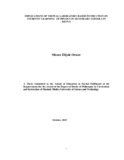| dc.description.abstract | However, in the recent years, low candidature has been witnessed at the Kenya Certificate
of Secondary Education (KCSE) level in Physics, which can be attributed to low student
motivation and consistent poor performance in the subject. For instance, in the years
2016, 2017, 2018 and 2019 Kisumu County registered low mean scores of 4.23, 4.98,
4.67 and 4.10 respectively in Physics in KCSE. Therefore there is need for incorporation
of more effective teaching strategies for performance in Physics to improve, and for
students’ interest and attitude in learning the subject to change.The implementation of
relevant teaching strategies is critical in driving students’ active classroom participation
in achieving learning outcomes in Physics. To this end, it is impossible to ignore the
importance of Information Communication and Technology (ICT) integration in the
teaching of Physics in Kenyan secondary schools. Particularly, virtual reality devices are
becoming increasingly common and useful in the teaching and learning processes.
Enhanced with virtual reality technology, Virtual Laboratory-Based Instruction (VLBI)
has the potential to make unobservable phenomena accessible in any school, leading to
significant progress in the acquisition of science process skills. Technology-based or
technology enhanced learning leverages all learners, irrespective of their traits or socioeconomic
situation. This study aimed at establishing implications of integration of VLBI
on students’ learning of Physics in Secondary Schools in Kenya. This study was guided
by the following objectives: to establish the effect of VLBI on students’ level of
interaction in classroom; to establish the effect of VLBI on students’ achievement; to
compare the frequency of use of experimental teaching approach between VLBI
classroom and physical laboratory classroom and; to determine the relationship between
teachers’ knowledge on selected ICT frameworks and the use of VLBI. The study was
supported by behaviourism and connectivism learning theories and adopted Solomon-
Four Group- quasi experimental research designs. The study's target population consisted
of 3,500 Physics form three students and 88 Physics teachers from 230 Kisumu County
public secondary schools. Physics teachers were purposively sampled from each of the
schools selected. There were 358 students and 72 teachers as the sample. Data collection
was done using Physics Teachers Questionnaire, Physics Achievement Test for students,
Physics Students’ Questionnaire and Lesson Observation Schedule. Data presentation
was made using frequency tables, figures and analysed using inferential statistics. The
inferential statistics involved the use of ANOVA, t-test, multiple regression analysis and
Duncan post-hoc tests. Qualitative data was analysed thematically. Results of the study
indicated significant differences between experimental groups and control groups on
level of classroom interaction (F=123.3, p< 0.05), achievement in physics (F=115.7, p<
0.05), and number of experiments conducted (119.97, p< 0.05). However, the study
established that there was no significant difference (F=1.174, p> 0.05) between teachers’
knowledge and use of VLBI. The study concluded that 64.5% of variance in the VLBI
was explained by learners’ interaction in the classroom, learners’ achievement, number
of virtual experiments conducted and the teachers’ knowledge on the selected ICT
frameworks. The findings generated from this study may give educational researchers,
planners and secondary school teachers an opportunity to design and put into practice
various classroom based innovations that would enable seamless integration of ICT in
classroom instruction. | en_US |

